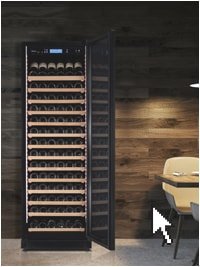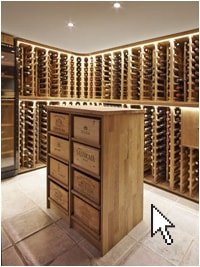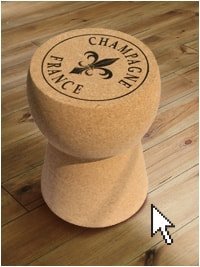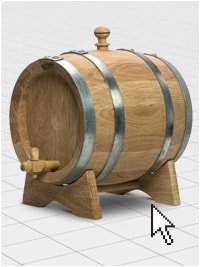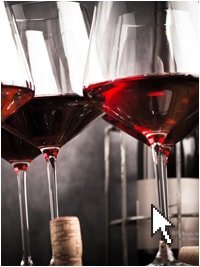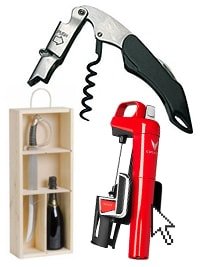A wine cooler can get damaged by lying down
If you have chosen to pick up your wine cooler yourself, it is important that it is kept standing upright during the transport. In some cases the compressor / cooling system can get damage, if it has been laid down during transport.
Therefore, we recommend that you get the wine cooler delivered by professionals who can transport the wine cooler upright throughout the transport.
Wait before plugging in the wine fridge
Once you have placed your wine cooler where it should be, wait 24-48 hours (Eurocave always 48 hours) before connecting power to the cabinet. It is important for the wine cooler to stand still after it has been transported.
It is also important that the wine cooler is in an absolutely perfectly levelled position.
Use the waiting time to fill the wine cooler with bottles.
How to store your wine bottles in the best way
All manufacturers of wine coolers refers to the bottle type Bordeaux when they specify the bottle capacity of the wine cooler. But few people only have Bordeaux bottles. There are many bottles that are both thicker and longer than Bordeaux bottles. So expect that you have room for about 70% of the stated number of Bordeaux bottles if you have mixed bottle sizes. Do not fill your wine cooler too much as it is important that there is room for air to circulate inside the wine cooler so you get a constant temperature throughout the cooling zone.
Learn more about how to store the bottles in the best way, temperature and humidity here.
Mold and mildew in the wine cooler
Generally, air exchange is a good thing against moisture. After all, this applies to everything from basements, sheds and also wine cabinets. So total opening and venting of the wine fridge once in a while is a good idea.
However, it may happen that mold occur in a wine refrigerato. Fortunately, this can be remedied with a good and thorough cleaning, which, by the way is a good idea to do twice a year.
We recommend a mold and mildew remover product used along with a regular main cleaning of the wine refrigerator. Take out the wine bottles and wash the inside of the cabinet with light soapy water and rinse with clean water at last.
Then, when you put the bottles back in the cabinet, try to prevent them from touching the back wall inside the cabinet. In this way you help the air circulation, which is good against mold and mildew.
Finally, you can wrap the bottles in food wrapping film before racking them in the wine cabinet. This way you protect the labels while the bottles are easier to stack inside the cabinet. You can also spray hair lacquer as a nice little protective film on the label, but we prefer wrapping film. On a dry bottle, of course…
When you connect your wine cooler
When you first connect your wine cooler it will run a lot because it will have to work a lot to cool down all the bottles. The entire cooling system is also about to start running for the first time.
In the beginning you will experience that the wine cooler will sound louder than normal, as well as start and stop more times than normal.
Noise from the wine cooler
A wine cooler sounds more than a conventional refrigerator. This is due to, among other things, fans inside the cabinet that distributes cold air to achieve a constant temperature throughout the cooling zone. There is also a big difference in how sound is perceived depending on the acoustics of the room where you have placed the wine cooler.
Learn more about noise from wine coolers and what you should consider here.
Temperature fluctuations
Once you have set the wine cooler to the desired temperature, it is very normal that the temperature will fluctuate up and down plus / minus a few degrees. This varies depending on whether the cabinet will be cooled further down after that it just has cooled down.
These temperature fluctuations are normal and the wine will not get affected because it takes longer for the liquid to change temperature than it does for the air in the cabinet.
Filling a wine cooler with bottles will help maintain a more stable temperature inside the wine cooler.
Connect your wine cooler to an earth connection plug!
It’s important that you connect your wine cooler using an earth connection plug. This is for your own safety and because some wine coolers (especially thermoelectric wine coolers) risk breaking down if not connected to an active earth connection.
See more in the user's manual
For other instructions and how to use your wine cooler, we refer to the manual that you can find here.
How to pull out a shelve
What is the best position for wine bottles in a wine cooler?
The bottles you wish to store for the longest period of time are a good idea to store in pre-determined shelves that you don’t pull out too often. You can also have defined shelves for the wines you drink from time to time that are being replaced more often. In this way, you allow the wines, which are being stored for a longer period, to have the most amount of calm and quiet, making sure they are not shaken unnecessarily.
Temperature and humidity in a wine cooler
If you need the wine cooler for short-term storage or as a serving cooler, where you often remove a bottle or two, and replace them, the ideal temperature would be about 15-16 degrees. Making sure that the wine gets the right serving temperature at 16-18 degrees faster.
If you have white wines etc. you will either need a wine cooler with two cooling zones, where you put one zone on 6-8 degrees for the whites, and then use the other zone for red wines. If you only have one zone, you will need to take the white wine or champagne out of the wine cooler a while before drinking and place it in a normal fridge, which is usually set to 5 degrees.
Moisture in the air can also be a factor when you are long-term storing wine. The ideal humidity would be at 50-75%. If the humidity level gets too high, you risk the cork starts to rot or crumble, and if it is too low, you risk the cork drying out. Most wine coolers maintain the correct humidity themselves through the vaporizer within the cooler, others simply maintain it when you open and close the door.
If you are long-term storing wine, I suggest that you invest in a hygrometer, or use our smart wireless system from Sensorist, which keeps an eye on both humidity level and temperature through the Internet or an app.
Get help finding out which wine cooler you need by using our wine cooler guide. In this guide all of our products are divided into different categories, depending on number of bottles, low energy, level of noise and much more.
















